tailgate VOLKSWAGEN POLO 2015 OwnerôÇs Manual
[x] Cancel search | Manufacturer: VOLKSWAGEN, Model Year: 2015, Model line: POLO, Model: VOLKSWAGEN POLO 2015Pages: 100, PDF Size: 4.14 MB
Page 6 of 100
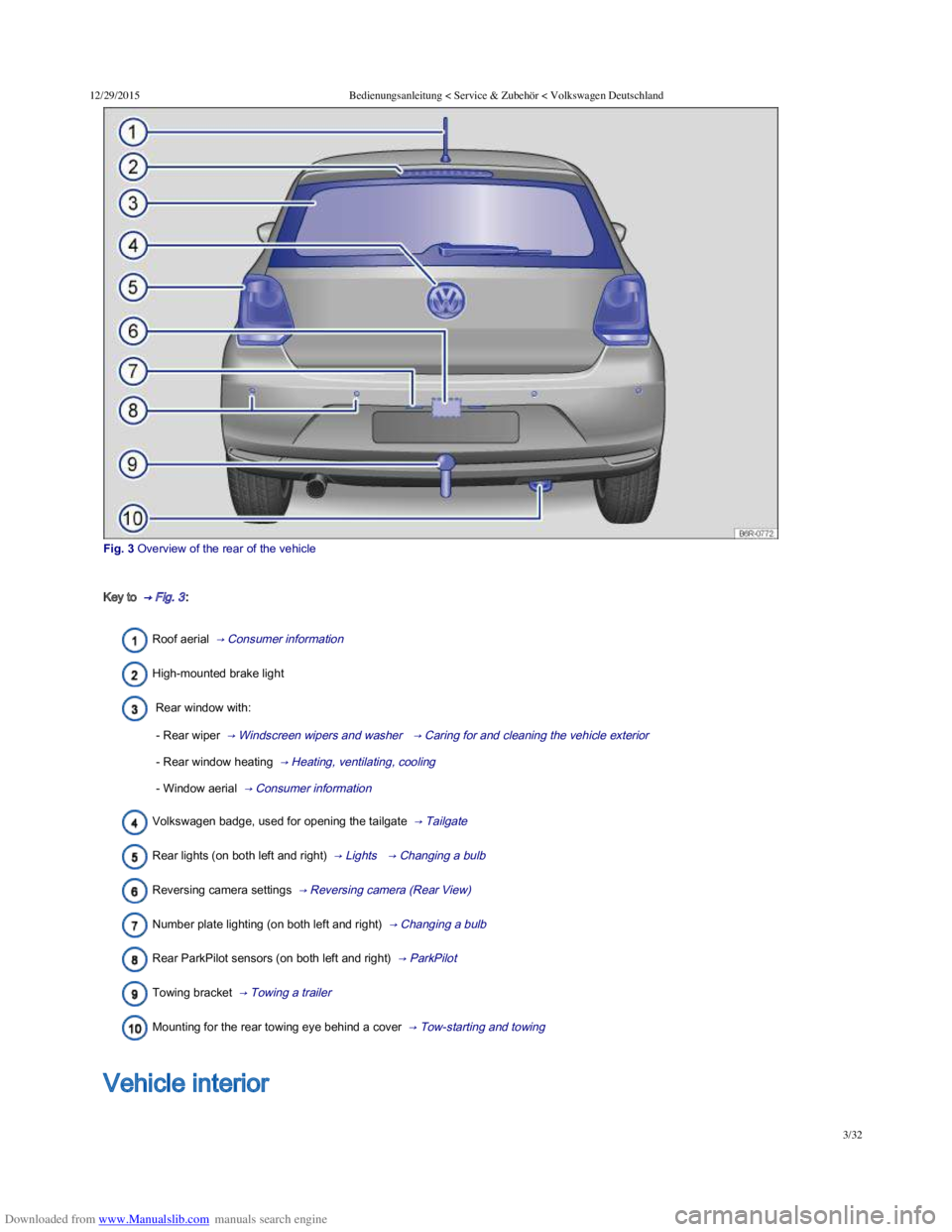
Downloaded from www.Manualslib.com manuals search engine 12/29/2015Bedienungsanleitung < Service & ZubehûÑr < Volkswagen Deutschland
3/32
Fig.ô 3ô Overviewô ofô theô rearô ofô theô vehicle
Key to ô ãô Fig.ô 3ã₤:
Roof aerial ô ãô Consumer information ã₤
High-mounted brake light
Rear window with:
- Rear wiperô ô ãô Windscreen wipers and washer ã₤ ô ãô Caring for and cleaning the vehicle exterior ã₤
- Rear window heating ô ãô Heating, ventilating, cooling ã₤
- Window aerial ô ãô Consumer information ã₤
Volkswagen badge, used for opening the tailgate ô ãô Tailgate ã₤
Rear lights (on both left and right) ô ãô Lights ã₤ ô ãô Changing a bulb ã₤
Reversing camera settings ô ãô Reversing camera (Rear View) ã₤
Number plate lighting (on both left and right) ô ãô Changing a bulb ã₤
Rear ParkPilot sensors (on both left and right) ô ãô ParkPilot ã₤
Towing bracket ô ãô Towing a trailer ã₤
Mounting for the rear towing eye behind a cover ô ãô Tow-starting and towing ã₤
Overview of the driver door
Vehicle interior
Page 14 of 100
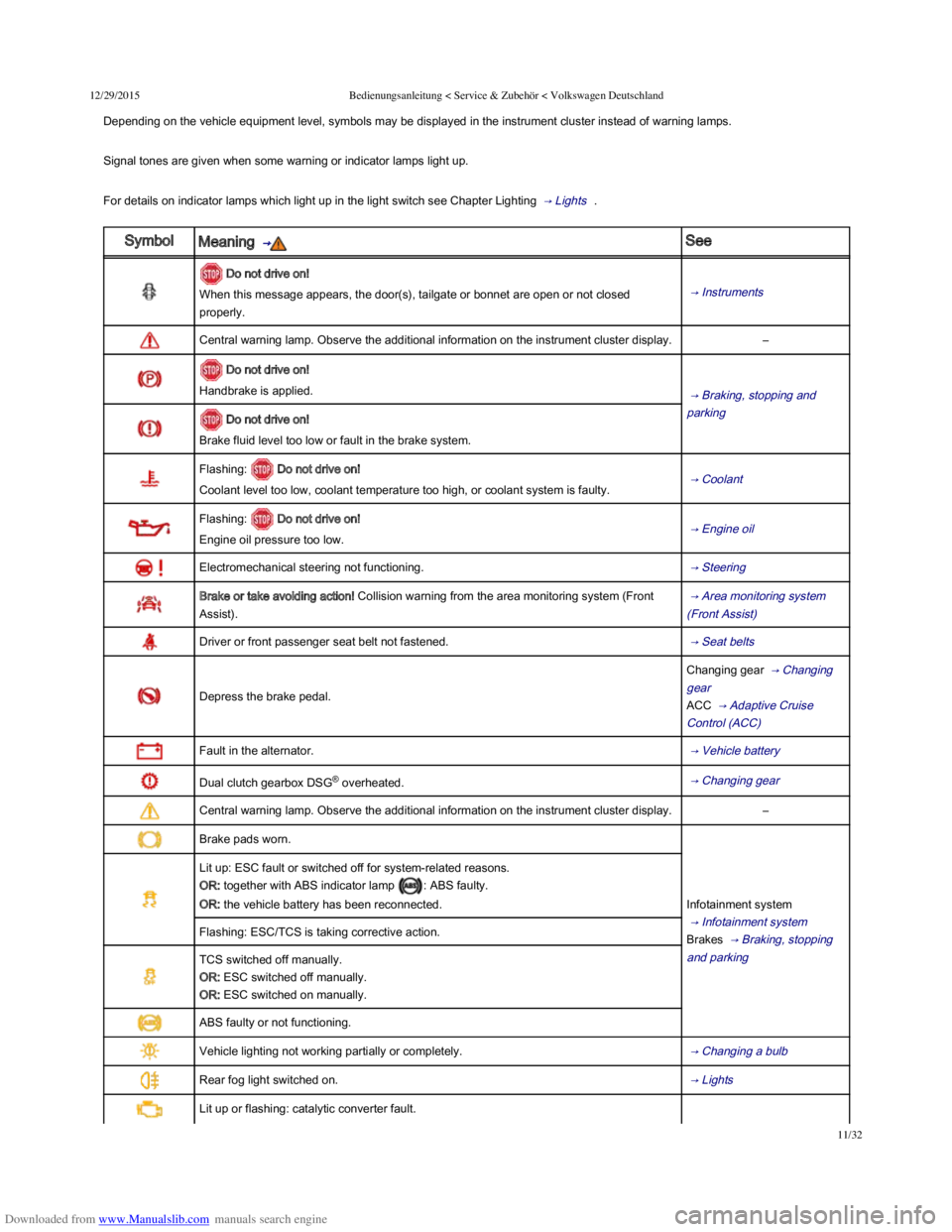
Downloaded from www.Manualslib.com manuals search engine 12/29/2015Bedienungsanleitung < Service & ZubehûÑr < Volkswagen Deutschland
11/32
Depending on the vehicle equipment level, symbols may be displayed in the instrument cluster instead of warning lamps.
Signal tones are given when some warning or indicator lamps light up.
For details on indicator lamps which light up in the light switch see Chapter Lighting ô ãô Lights ã₤ .
SymbolMeaning ô ãã₤See
Do not drive on!
When this message appears, the door(s), tailgate or bonnet are open or not closed
properly.
ô ãô Instrumentsã₤
Central warning lamp. Observe the additional information on the instrument cluster display.ã
Do not drive on!
Handbrake is applied.ô ãô Braking, stopping and
parking ã₤ Do not drive on!
Brake fluid level too low or fault in the brake system.
Flashing: Do not drive on!
Coolant level too low, coolant temperature too high, or coolant system is faulty.ô ãô Coolant ã₤
Flashing: Do not drive on!
Engine oil pressure too low.ô ãô Engine oil ã₤
Electromechanical steering not functioning.ô ãô Steering ã₤
Brake or take avoiding action! Collision warning from the area monitoring system (Front
Assist).
ô ãô Area monitoring system
(Front Assist) ã₤
Driver or front passenger seat belt not fastened.ô ãô Seat belts ã₤
Depress the brake pedal.
Changing gear ô ãô Changing
gear ã₤
ACC ô ãô Adaptive Cruise
Control (ACC) ã₤
Fault in the alternator.ô ãô Vehicle battery ã₤
Dual clutch gearbox DSGôÛ overheated.ô ãô Changing gear ã₤
Central warning lamp. Observe the additional information on the instrument cluster display.ã
Brake pads worn.
Infotainment system
ô ãô Infotainment systemã₤
Brakes ô ãô Braking, stopping
and parking ã₤
Lit up: ESC fault or switched off for system-related reasons.
OR: together with ABS indicator lamp : ABS faulty.
OR: the vehicle battery has been reconnected.
Flashing: ESC/TCS is taking corrective action.
TCS switched off manually.
OR: ESC switched off manually.
OR: ESC switched on manually.
ABS faulty or not functioning.
Vehicle lighting not working partially or completely.ô ãô Changing a bulb ã₤
Rear fog light switched on.ô ãô Lights ã₤
Lit up or flashing: catalytic converter fault.
Starting the engine ô ãô Starting
Page 18 of 100
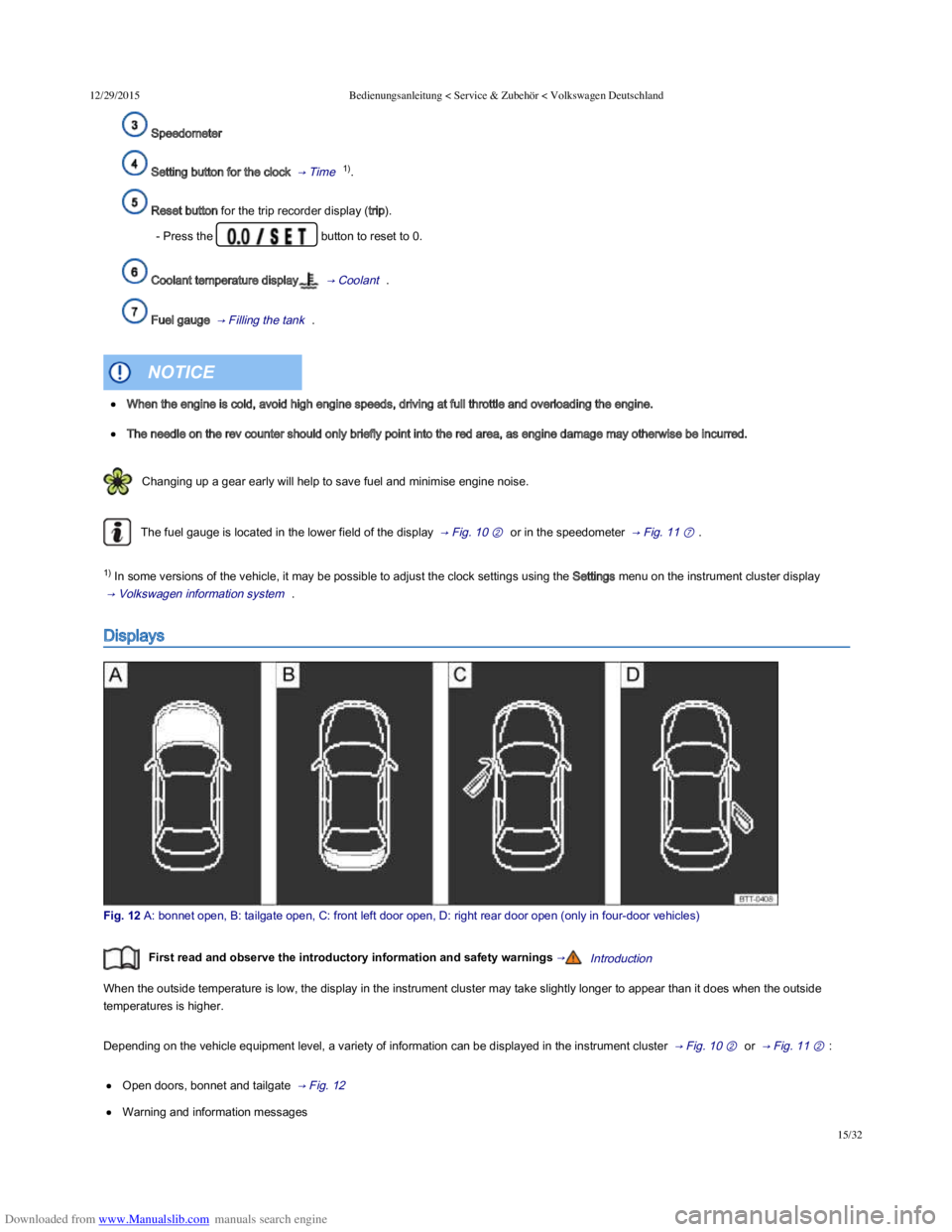
Downloaded from www.Manualslib.com manuals search engine 12/29/2015Bedienungsanleitung < Service & ZubehûÑr < Volkswagen Deutschland
15/32
Speedometer
Setting button for the clock ô ãô Time ã₤ 1).
Reset button for the trip recorder display (trip).
- Press theô button to reset to 0.
Coolant temperature display ô ãô Coolant ã₤ .
Fuel gauge ô ãô Filling the tank ã₤ .
ô Changing up a gear early will help to save fuel and minimise engine noise.
The fuel gauge is located in the lower field of the display ô ãô Fig.ô 10 ãÀ ã₤ or in the speedometer ô ãô Fig.ô 11 ãÎ ã₤.
1) In some versions of the vehicle, it may be possible to adjust the clock settings using the Settings menu on the instrument cluster display
ô ãô Volkswagen information system ã₤ .
Displays
Fig.ô 12ô A:ô bonnetô open,ô B:ô tailgateô open,ô C:ô frontô leftô doorô open,ô D:ô rightô rearô doorô openô (onlyô inô fourôÙdoorô vehicles)
Firstô readô andô observeô theô introductoryô informationô andô safetyô warningsô ãIntroductionã₤
When the outside temperature is low, the display in the instrument cluster may take slightly longer to appear than it does when the outside
temperatures is higher.
Depending on the vehicle equipment level, a variety of information can be displayed in the instrument cluster ô ãô Fig.ô 10 ãÀ ã₤ or ô ãô Fig.ô 11 ãÀ ã₤:
Open doors, bonnet and tailgate ô ãô Fig.ô 12ã₤
Warning and information messages
When the engine is cold, avoid high engine speeds, driving at full throttle and overloading the engine.
The needle on the rev counter should only briefly point into the red area, as engine damage may otherwise be incurred.
NOTICE
Page 19 of 100
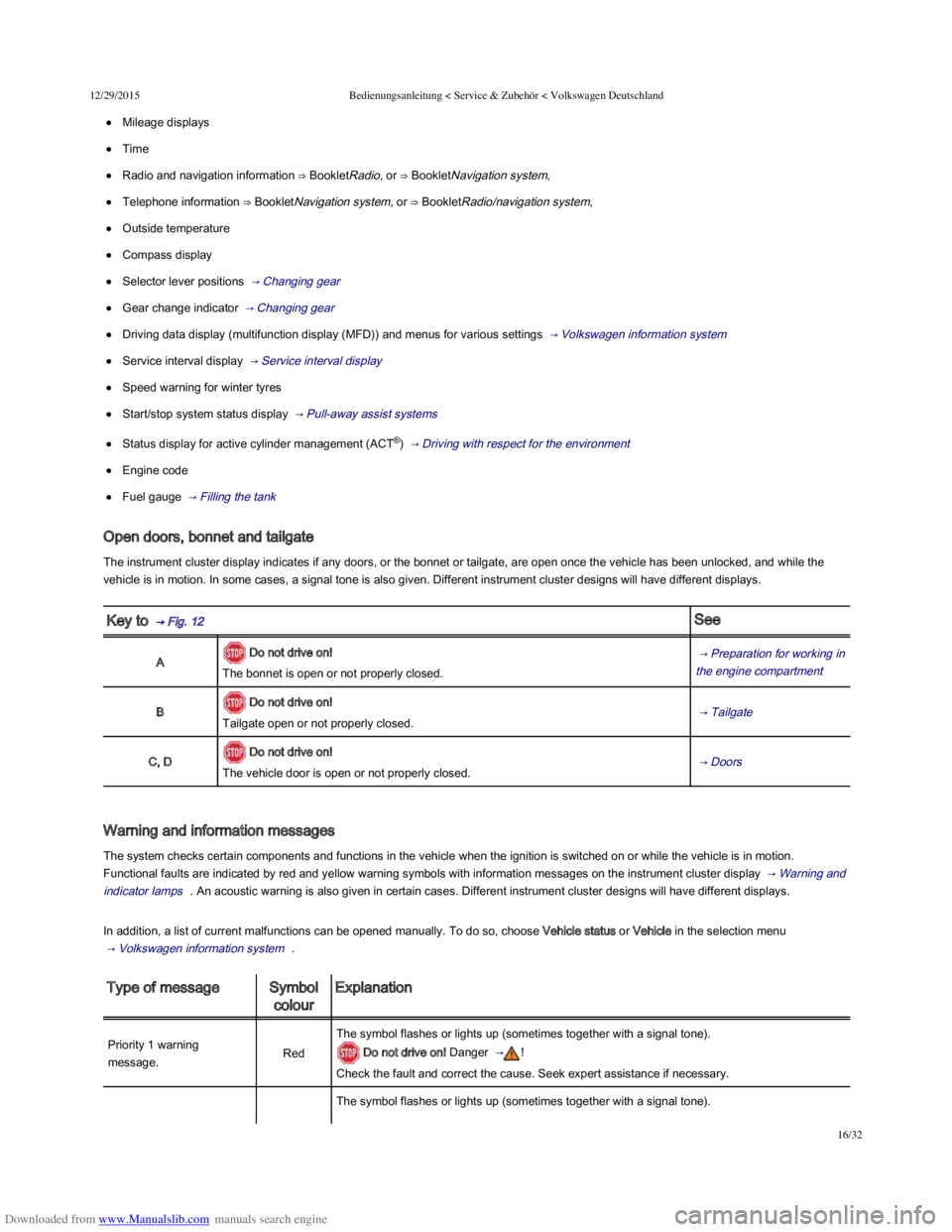
Downloaded from www.Manualslib.com manuals search engine 12/29/2015Bedienungsanleitung < Service & ZubehûÑr < Volkswagen Deutschland
16/32
Mileage displays
Time
Radio and navigation information ãô BookletRadio, or ãô BookletNavigation system,
Telephone information ãô BookletNavigation system, or ãô BookletRadio/navigation system,
Outside temperature
Compass display
Selector lever positions ô ãô Changing gear ã₤
Gear change indicator ô ãô Changing gear ã₤
Driving data display (multifunction display (MFD)) and menus for various settings ô ãô Volkswagen information system ã₤
Service interval display ô ãô Service interval display ã₤
Speed warning for winter tyres
Start/stop system status display ô ãô Pull-away assist systems ã₤
Status display for active cylinder management (ACTôÛ) ô ãô Driving with respect for the environment ã₤
Engine code
Fuel gauge ô ãô Filling the tank ã₤
Open doors, bonnet and tailgate
The instrument cluster display indicates if any doors, or the bonnet or tailgate, are open once the vehicle has been unlocked, and while the
vehicle is in motion. In some cases, a signal tone is also given. Different instrument cluster designs will have different displays.
Key to ô ãô Fig.ô 12ã₤See
A Do not drive on!
The bonnet is open or not properly closed.
ô ãô Preparation for working in
the engine compartment ã₤
B Do not drive on!
Tailgate open or not properly closed.ô ãô Tailgate ã₤
C, D Do not drive on!
The vehicle door is open or not properly closed.ô ãô Doors ã₤
Warning and information messages
The system checks certain components and functions in the vehicle when the ignition is switched on or while the vehicle is in motion.
Functional faults are indicated by red and yellow warning symbols with information messages on the instrument cluster display ô ãô Warning and
indicator lamps ã₤ . An acoustic warning is also given in certain cases. Different instrument cluster designs will have different displays.
In addition, a list of current malfunctions can be opened manually. To do so, choose Vehicle status or Vehicle in the selection menu
ô ãô Volkswagen information system ã₤ .
Type of messageSymbol
colour
Explanation
Priorityô 1 warning
message.Red
The symbol flashes or lights up (sometimes together with a signal tone).
Do not drive on! Danger ô ãã₤!
Check the fault and correct the cause. Seek expert assistance if necessary.
The symbol flashes or lights up (sometimes together with a signal tone).
Page 42 of 100
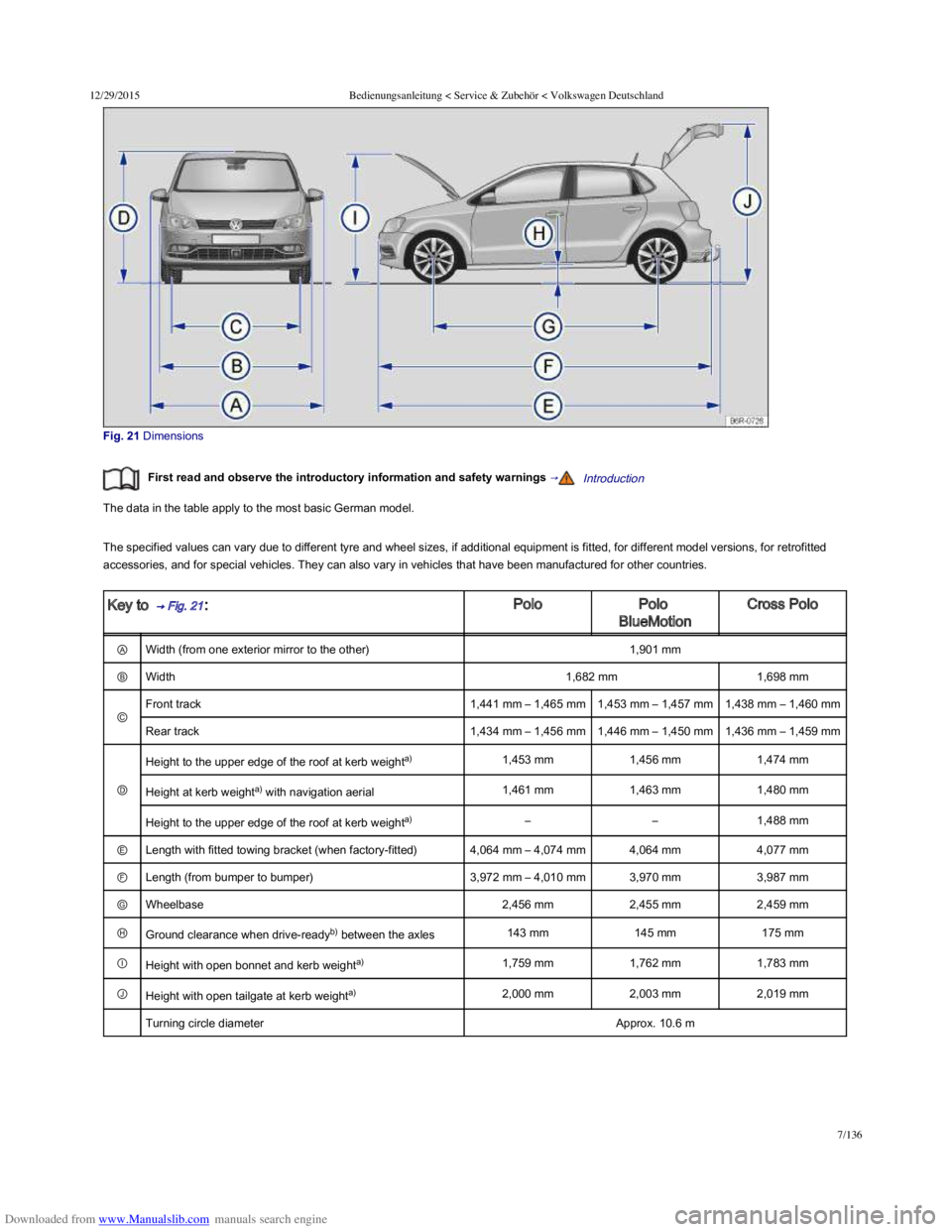
Downloaded from www.Manualslib.com manuals search engine 12/29/2015Bedienungsanleitung < Service & ZubehûÑr < Volkswagen Deutschland
7/136
Fig.ô 21ô Dimensions
Firstô readô andô observeô theô introductoryô informationô andô safetyô warningsô ãIntroductionã₤
The data in the table apply to the most basic German model.
The specified values can vary due to different tyre and wheel sizes, if additional equipment is fitted, for different model versions, for retrofitted
accessories, and for special vehicles. They can also vary in vehicles that have been manufactured for other countries.
Key to ô ãô Fig.ô 21ã₤:PoloPolo
BlueMotion
Cross Polo
ãÑWidth (from one exterior mirror to the other)1,901 mm
ãñWidth1,682 mm1,698 mm
ã¡
Front track1,441 mm ã 1,465 mm1,453 mm ã 1,457 mm1,438 mm ã 1,460 mm
Rear track1,434 mm ã 1,456 mm1,446 mm ã 1,450 mm1,436 mm ã 1,459 mm
ã¿
Height to the upper edge of the roof at kerb weighta)1,453 mm1,456 mm1,474 mm
Height at kerb weighta) with navigation aerial1,461 mm1,463 mm1,480 mm
Height to the upper edge of the roof at kerb weighta)ãã1,488 mm
ã¤Length with fitted towing bracket (when factory-fitted)4,064 mm ã 4,074 mm4,064 mm4,077 mm
ã£Length (from bumper to bumper)3,972 mm ã 4,010 mm3,970 mm3,987 mm
ã¥Wheelbase2,456 mm2,455 mm2,459 mm
ã§Ground clearance when drive-readyb) between the axles143 mm145 mm175 mm
ãƒHeight with open bonnet and kerb weighta)1,759 mm1,762 mm1,783 mm
ã¢Height with open tailgate at kerb weighta)2,000 mm2,003 mm2,019 mm
ô Turning circle diameterApprox. 10.6 m
Page 44 of 100
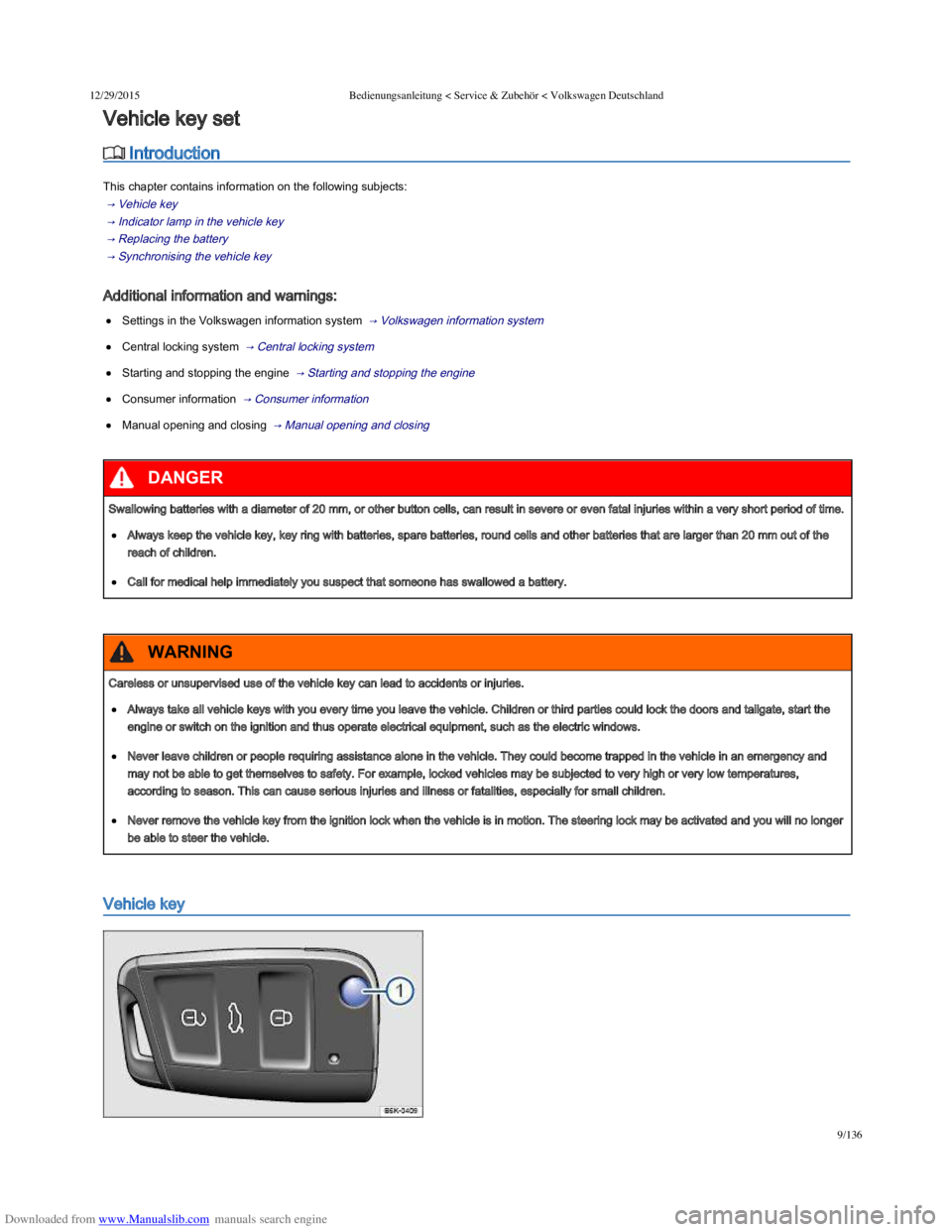
Downloaded from www.Manualslib.com manuals search engine 12/29/2015Bedienungsanleitung < Service & ZubehûÑr < Volkswagen Deutschland
9/136
ô Introduction
Thisô chapterô containsô informationô onô theô followingô subjects:
ô ãô Vehicle key ã₤
ô ãô Indicator lamp in the vehicle key ã₤
ô ãô Replacing the battery ã₤
ô ãô Synchronising the vehicle key ã₤
Additional information and warnings:
Settings in the Volkswagen information system ô ãô Volkswagen information system ã₤
Central locking system ô ãô Central locking system ã₤
Starting and stopping the engine ô ãô Starting and stopping the engine ã₤
Consumer information ô ãô Consumer information ã₤
Manual opening and closing ô ãô Manual opening and closing ã₤
Vehicle key
Vehicle key set
Swallowing batteries with a diameter of 20ô mm, or other button cells, can result in severe or even fatal injuries within a very short period of time.
Always keep the vehicle key, key ring with batteries, spare batteries, round cells and other batteries that are larger than 20ô mm out of the
reach of children.
Call for medical help immediately you suspect that someone has swallowed a battery.
DANGER
Careless or unsupervised use of the vehicle key can lead to accidents or injuries.
Always take all vehicle keys with you every time you leave the vehicle. Children or third parties could lock the doors and tailgate, start the
engine or switch on the ignition and thus operate electrical equipment, such as the electric windows.
Never leave children or people requiring assistance alone in the vehicle. They could become trapped in the vehicle in an emergency and
may not be able to get themselves to safety. For example, locked vehicles may be subjected to very high or very low temperatures,
according to season. This can cause serious injuries and illness or fatalities, especially for small children.
Never remove the vehicle key from the ignition lock when the vehicle is in motion. The steering lock may be activated and you will no longer
be able to steer the vehicle.
WARNING
Page 47 of 100
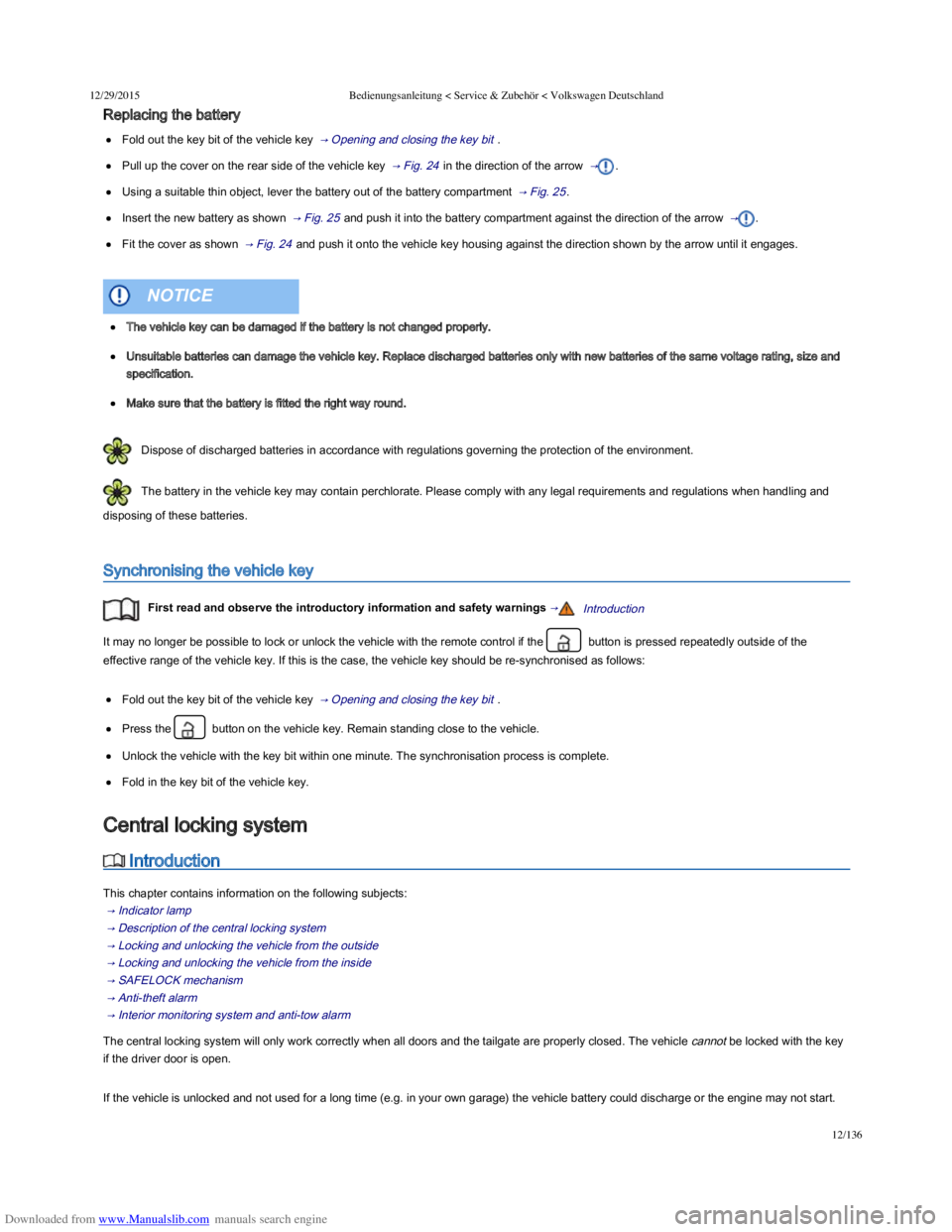
Downloaded from www.Manualslib.com manuals search engine 12/29/2015Bedienungsanleitung < Service & ZubehûÑr < Volkswagen Deutschland
12/136
Replacing the battery
Fold out the key bit of the vehicle key ô ãô Opening and closing the key bitã₤ .
Pull up the cover on the rear side of the vehicle key ô ãô Fig.ô 24ã₤ in the direction of the arrow ô ãã₤.
Using a suitable thin object, lever the battery out of the battery compartment ô ãô Fig.ô 25ã₤.
Insert the new battery as shown ô ãô Fig.ô 25ã₤ and push it into the battery compartment against the direction of the arrow ô ãã₤.
Fit the cover as shown ô ãô Fig.ô 24ã₤ and push it onto the vehicle key housing against the direction shown by the arrow until it engages.
ô Dispose of discharged batteries in accordance with regulations governing the protection of the environment.
ô The battery in the vehicle key may contain perchlorate. Please comply with any legal requirements and regulations when handling and
disposing of these batteries.
Synchronising the vehicle key
Firstô readô andô observeô theô introductoryô informationô andô safetyô warningsô ãIntroductionã₤
It may no longer be possible to lock or unlock the vehicle with the remote control if theô ô button is pressed repeatedly outside of the
effective range of the vehicle key. If this is the case, the vehicle key should be re-synchronised as follows:
Fold out the key bit of the vehicle key ô ãô Opening and closing the key bitã₤ .
Press the ô button on the vehicle key. Remain standing close to the vehicle.
Unlock the vehicle with the key bit within one minute. The synchronisation process is complete.
Fold in the key bit of the vehicle key.
ô Introduction
Thisô chapterô containsô informationô onô theô followingô subjects:
ô ãô Indicator lamp ã₤
ô ãô Description of the central locking system ã₤
ô ãô Locking and unlocking the vehicle from the outside ã₤
ô ãô Locking and unlocking the vehicle from the inside ã₤
ô ãô SAFELOCK mechanism ã₤
ô ãô Anti-theft alarm ã₤
ô ãô Interior monitoring system and anti-tow alarm ã₤
The central locking system will only work correctly when all doors and the tailgate are properly closed. The vehicle cannot be locked with the key
if the driver door is open.
If the vehicle is unlocked and not used for a long time (e.g. in your own garage) the vehicle battery could discharge or the engine may not start.
The vehicle key can be damaged if the battery is not changed properly.
Unsuitable batteries can damage the vehicle key. Replace discharged batteries only with new batteries of the same voltage rating, size and
specification.
Make sure that the battery is fitted the right way round.
NOTICE
Central locking system
Page 48 of 100
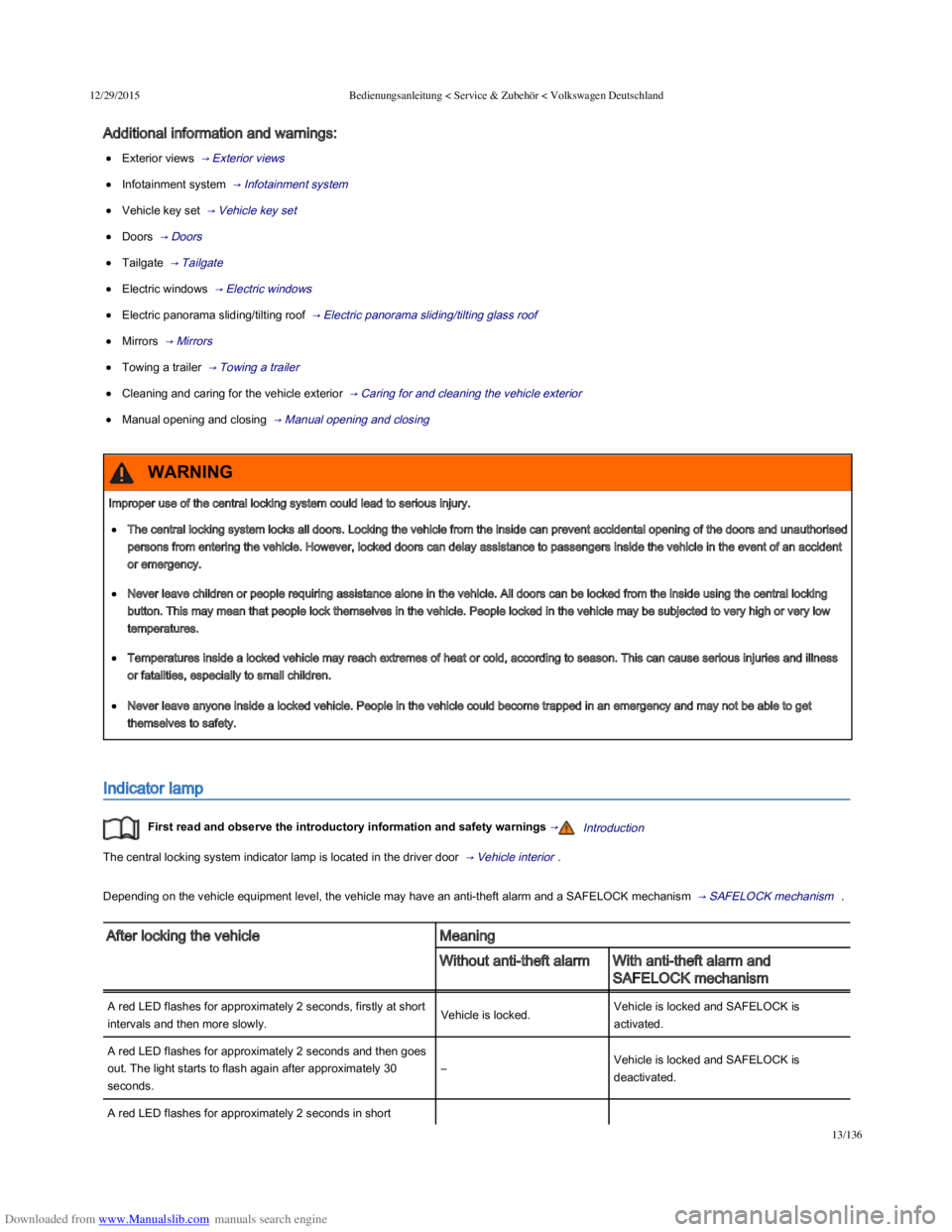
Downloaded from www.Manualslib.com manuals search engine 12/29/2015Bedienungsanleitung < Service & ZubehûÑr < Volkswagen Deutschland
13/136
Additional information and warnings:
Exterior views ô ãô Exterior views ã₤
Infotainment system ô ãô Infotainment systemã₤
Vehicle key set ô ãô Vehicle key set ã₤
Doors ô ãô Doors ã₤
Tailgate ô ãô Tailgate ã₤
Electric windows ô ãô Electric windows ã₤
Electric panorama sliding/tilting roof ô ãô Electric panorama sliding/tilting glass roof ã₤
Mirrors ô ãô Mirrors ã₤
Towing a trailer ô ãô Towing a trailer ã₤
Cleaning and caring for the vehicle exterior ô ãô Caring for and cleaning the vehicle exterior ã₤
Manual opening and closing ô ãô Manual opening and closing ã₤
Indicator lamp
Firstô readô andô observeô theô introductoryô informationô andô safetyô warningsô ãIntroductionã₤
The central locking system indicator lamp is located in the driver door ô ãô Vehicle interiorã₤ .
Depending on the vehicle equipment level, the vehicle may have an anti-theft alarm and a SAFELOCK mechanism ô ãô SAFELOCK mechanism ã₤ .
After locking the vehicleMeaning
Without anti-theft alarmWith anti-theft alarm and
SAFELOCK mechanism
A red LED flashes for approximately 2ô seconds, firstly at short
intervals and then more slowly.Vehicle is locked.Vehicle is locked and SAFELOCK is
activated.
A red LED flashes for approximately 2 seconds and then goes
out. The light starts to flash again after approximately 30
seconds.
ãVehicle is locked and SAFELOCK is
deactivated.
A red LED flashes for approximately 2ô seconds in short
Improper use of the central locking system could lead to serious injury.
The central locking system locks all doors. Locking the vehicle from the inside can prevent accidental opening of the doors and unauthorised
persons from entering the vehicle. However, locked doors can delay assistance to passengers inside the vehicle in the event of an accident
or emergency.
Never leave children or people requiring assistance alone in the vehicle. All doors can be locked from the inside using the central locking
button. This may mean that people lock themselves in the vehicle. People locked in the vehicle may be subjected to very high or very low
temperatures.
Temperatures inside a locked vehicle may reach extremes of heat or cold, according to season. This can cause serious injuries and illness
or fatalities, especially to small children.
Never leave anyone inside a locked vehicle. People in the vehicle could become trapped in an emergency and may not be able to get
themselves to safety.
WARNING
Page 49 of 100
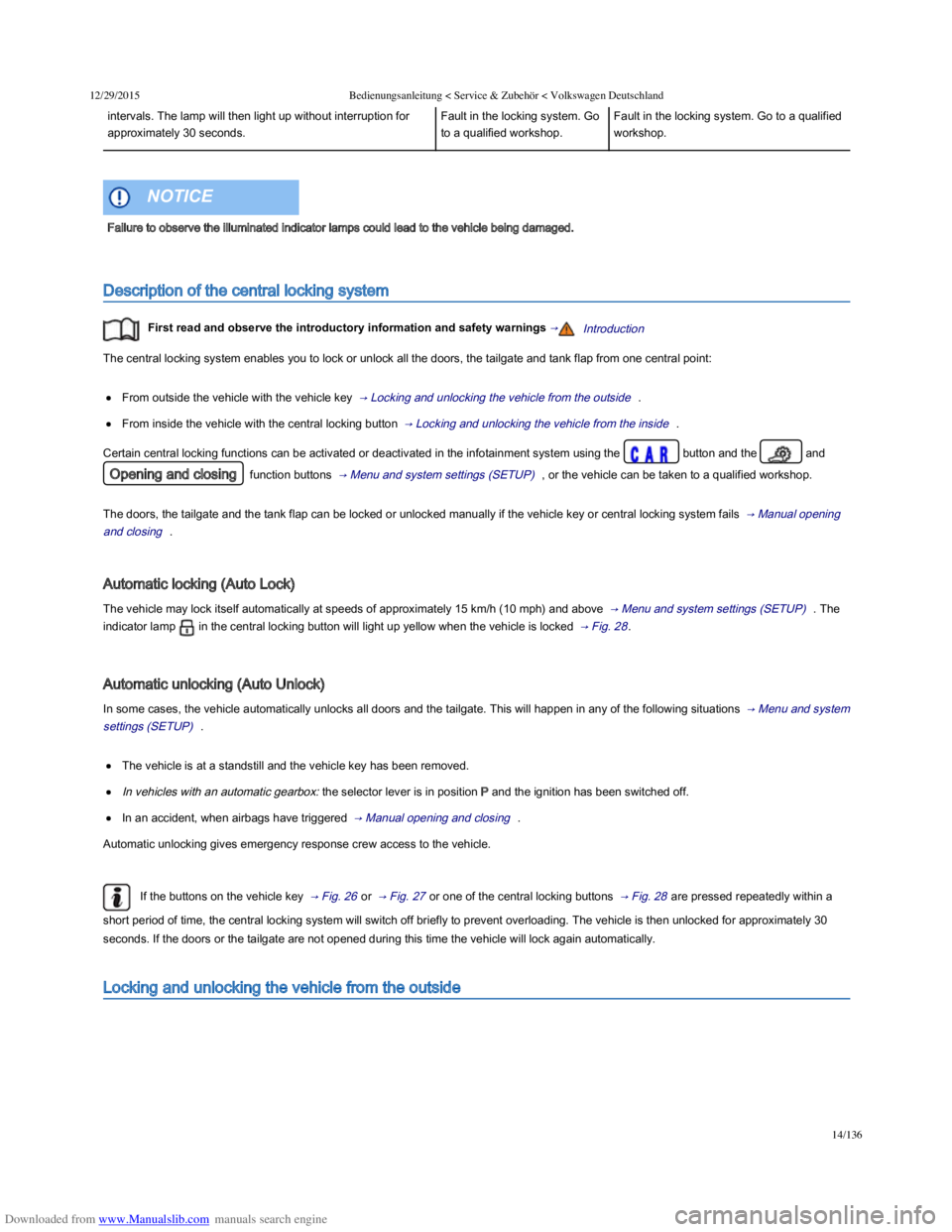
Downloaded from www.Manualslib.com manuals search engine 12/29/2015Bedienungsanleitung < Service & ZubehûÑr < Volkswagen Deutschland
14/136
intervals. The lamp will then light up without interruption for
approximately 30 seconds.
Fault in the locking system. Go
to a qualified workshop.
Fault in the locking system. Go to a qualified
workshop.
Description of the central locking system
Firstô readô andô observeô theô introductoryô informationô andô safetyô warningsô ãIntroductionã₤
The central locking system enables you to lock or unlock all the doors, the tailgate and tank flap from one central point:
From outside the vehicle with the vehicle key ô ãô Locking and unlocking the vehicle from the outside ã₤ .
From inside the vehicle with the central locking button ô ãô Locking and unlocking the vehicle from the inside ã₤ .
Certain central locking functions can be activated or deactivated in the infotainment system using the button and the and
Opening and closing function buttons ô ãô Menu and system settings (SETUP) ã₤ , or the vehicle can be taken to a qualified workshop.
The doors, the tailgate and the tank flap can be locked or unlocked manually if the vehicle key or central locking system fails ô ãô Manual opening
and closing ã₤ .
Automatic locking (Auto Lock)
The vehicle may lock itself automatically at speeds of approximately 15ô km/h (10ô mph) and above ô ãô Menu and system settings (SETUP) ã₤ . The
indicator lampô in the central locking button will light up yellow when the vehicle is locked ô ãô Fig.ô 28ã₤.
Automatic unlocking (Auto Unlock)
In some cases, the vehicle automatically unlocks all doors and the tailgate. This will happen in any of the following situations ô ãô Menu and system
settings (SETUP) ã₤ .
The vehicle is at a standstill and the vehicle key has been removed.
In vehicles with an automatic gearbox: the selector lever is in positionô P and the ignition has been switched off.
In an accident, when airbags have triggered ô ãô Manual opening and closing ã₤ .
Automatic unlocking gives emergency response crew access to the vehicle.
If the buttons on the vehicle key ô ãô Fig.ô 26ã₤ or ô ãô Fig.ô 27ã₤ or one of the central locking buttons ô ãô Fig.ô 28ã₤ are pressed repeatedly within a
short period of time, the central locking system will switch off briefly to prevent overloading. The vehicle is then unlocked for approximately 30
seconds. If the doors or the tailgate are not opened during this time the vehicle will lock again automatically.
Locking and unlocking the vehicle from the outside
Failure to observe the illuminated indicator lamps could lead to the vehicle being damaged.
NOTICE
Page 50 of 100

Downloaded from www.Manualslib.com manuals search engine 12/29/2015Bedienungsanleitung < Service & ZubehûÑr < Volkswagen Deutschland
15/136
Fig.ô 26ô Buttonsô onô theô vehicleô key
Fig.ô 27ô Mechanicalô vehicleô key
Firstô readô andô observeô theô introductoryô informationô andô safetyô warningsô ãIntroductionã₤
FunctionButtons to be used in the vehicle key ô ãô Fig.ô 26ã₤Action to be followed with key in the lock cylinder
ô ãô Fig.ô 26ã₤ orô ô ãô Fig.ô 27ã₤
Unlocking the
vehicle.
Press theô button. Press and hold for convenience
opening.
Insert the vehicle key in the driver door lock cylinder and turn
anticlockwise. Turn and hold for convenience opening.
Locking the
vehicle.
Press theô button. Press and hold for convenience
closing. In vehicles with a SAFELOCK mechanism, press
the button once to lock the vehicle using the
SAFELOCK mechanism ô ãô SAFELOCK mechanism ã₤ .
Press the button twice to lock the vehicle without the
SAFELOCK mechanism.
Insert the vehicle key in the driver door lock cylinder and turn
clockwise. Turn and hold for convenience closing.
Unlocking the
tailgate.Press theô button ô ãô Tailgate ã₤ .Insert the vehicle key in the driver door lock cylinder and turn
anticlockwise.
Please note: depending on the central locking function that has been set in the infotainment system, all of the doors and the tailgate may only be
unlocked when the button is pressed twice ô ãô Menu and system settings (SETUP) ã₤ .
The vehicle key will lock or unlock the vehicle only when the battery has enough power and the key is located within a few metres of the vehicle.
When the vehicle is locked, all turn signals will flash once as confirmation.
When the vehicle is unlocked, all turn signals will flash twice as confirmation.
If the turn signals do not flash as confirmation when the vehicle has been locked, at least one of the doors or the tailgate is not closed.
The vehicle cannot be locked using the vehicle key if the driver door is still open. The vehicle will lock again automatically within a few seconds of
being unlocked if you do not open one of the doors or the tailgate. This function prevents the vehicle from remaining unlocked if the unlocking
button is pressed by mistake.